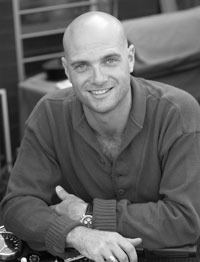Name Paul Carter Role Writer | Education University of Oxford | |
 | ||
Books Backstage handbook, Don't Tell Mom I Work on t, Material thinking, The road to Botany Bay, Dark writing Similar People Kate Thompson, Susan Hunt, Antonio Tabucchi | ||
Paul carter interview 9am with david kim
Life and career
Paul Carter was born and brought up in Faringdon, Oxon., UK attending a local grammar school and later Oxford University. In the 1970s he lived largely in Spain and Italy, working at a variety of jobs in order to support his own poetic education and cultural research. Moving to Australia in the early 1980s, he redirected his interests in poetics and aesthetics to the renarration of the conceptual foundations of white settler society in Australia. His book The Road to Botany Bay (1987) introduced the idea of ‘spatial history’ and was praised by Edward Said (‘a brilliantly daring notion of imperialism’) and Susan Sontag (an ‘ingenious account of nation-founding … itself a kind of founding book’). His follow-up publication, The Lie of the Land, has been widely recognised as a major contribution to postcolonial geography.
Contents
Research for this book stimulated an interest in the dynamics of cross-cultural communication, generating a body of radiophonic work and museum installation, supported respectively by the Australian Broadcasting Corporation and Radio Rundfunk, Cologne and (among others) Hyde Park Barracks (Sydney) and the Museum of Sydney. A multilingual soundscape (‘Columbus Echo’) designed for the Acquario di Genova led to a collaboration with composer Luciano Berio and to the ‘anti-novel’ Baroque Memories (the Italian translation included a preface by Antonio Tabucchi, who noted how a ‘further complication of an already complex situation produces, paradoxically, a simplification and, indeed, a resolution.’
In the late 1990s his studies in the mythopoetic mechanisms of placemaking led to major commissions as a public artist. Relay (with Ruark Lewis) for the Sydney 2000 Olympics and Nearamnew (a collaboration with Lab architecture studio and Karres en Brands) at Federation Square, Melbourne, used text, typography and ground patterning to integrate ‘reading’ and ‘treading.’ There followed numerous public space design projects, independently through the design studio Material Thinking, or in collaboration with leading Australian architects and landscape architects. His story-based tool for urban design and program integration, the ‘creative template’, was adopted by the Western Australian Government’s major planning agency, the Metropolitan Redevelopment Authority, in 2016.
His collaborations with artists between 1990 and 2004 were described in the book Material Thinking: the theory and practice of creative research (2004). More recently he has focused on the choreography of sociability in public settings, exploring the concept of the designer as dramaturg. His publications in this area are characterized as ‘cultural writing,’ as the vehicle of the analysis is invariably a distinctive literary style and narrative structure. In Meeting Place (2013) he differentiated between encounter and meeting to foreground the performative foundations of civil coexistence. Places Made After Their Stories (2015) introduces the notion of ‘choreotopography’ to characterize the arrangements that emerge from feedback between society and setting.
Paul has worked as a freelance writer (Books and Bookmen, Art and Artists, PNR Review), as a journalist (The Age Monthly Review, 1986-1990) and has held various research positions (University of Melbourne 1994-2008; Deakin University (2009-2011) and RMIT where he is Professor of Design (Urbanism).
Awards
2014. (with Rush Wright landscape architects) AILA Victoria Design in Landscape Architecture Excellence Award for Dandenong Civic Centre landscape.
2010. National Landscape Architecture Award of Excellence of the Australian Institute of Landscape Architects for Design for 'Golden Grove', Darlington Public Domain (University of Sydney) Stage Two (with Taylor, Cullity, Lethlean, Landscape Architects).
2010. Member of the following team selected to represent Australia at 2010 Venice Architecture Biennale: Loop-Pool / Saturation City, McGauran Giannini Soon (MGS), Bild + Dyskors, Material Thinking, MGS - Eli Giannini, Jocelyn Chiew, Catherine Ranger, Bild - Ben Milbourne, Dyskors - Edmund Carter, Material Thinking - Paul Carter.
2007. Merit Award for Design in Landscape Architecture (2007) of the Australian Institute of Landscape Architects (Victoria) (with Taylor, Cullity and Lethlean) for Darlington Public Domain Stage One, University of Sydney.
2004. Excellence for Planning Award of the Australian institute of Landscape Architects (with Taylor Cullity Lethlean, Peter Elliot Architects, and James Hayter and Associates) for North Terrace Precinct (Adelaide.
2003. Award for Design Excellence of the Australian Institute of Landscape Architects, Victoria and Tasmania (with Lab architecture studio, Bates Smart, Karres en Brands Landschapsarchitecten and Equinox Design Group) for Federation Square plaza.
2003. Award for Landscape Architecture of the Australian Institute of Landscape Architects, Victoria and Tasmania (with Lab architecture studio, Bates Smart, Karres en Brands Landschapsarchitecten and Equinox Design Group) for Federation Square plaza.
2003. The Woodward Medal for significant contributions to the Humanities and Social Sciences at the University of Melbourne.
1988. Victorian Premier’s Award for Non-Fiction for The Road to Botany Bay.
Publications
Recordings
In 2006 the Australian literary journal Southerly (vol. 66, no.2) released a CD sampler of my radio work. It featured the following extracts:
1. Memory as Desire (1986) 6:39; 2. What Is Your Name (1986) 5:08; 3. Scarlatti (1988) 5:49; 4. Remember Me (1988) 5:48; 5. On The Still Air (1990) 6:20; 6. The 7448 (1993) 6:21; 7. The Native Informant (1993) 5:47; 8. The Calling To Come (1995) 3:05; 9. The Museum (1995) 5:25; 10. Light (1996) 6:40; 11. Relay For Radio (2000) 3:53; 12. Underworlds of Jean du Chas (1998) 5:06; 13. The House That Flies (2002) 6:39; 14. Nearamnewspeak (2002) 5:33
